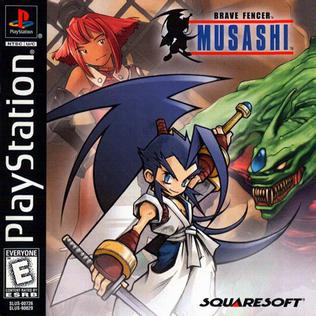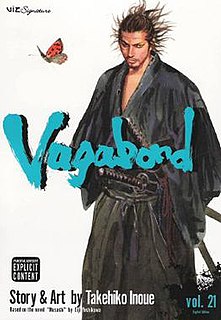A bokken is a Japanese wooden sword used for training. It is usually the size and shape of a katana, but is sometimes shaped like other swords, such as the wakizashi and tantō. Some ornamental bokken are decorated with mother-of-pearl work and elaborate carvings. Sometimes it is spelled "boken" in English. Bokken should not be confused with shinai, practice swords made of flexible bamboo.
Sasaki Kojirō, often anglicised to Kojirō Sasaki, was a prominent Japanese swordsman widely considered a master of his craft, born in Fukui Prefecture. He lived during the Azuchi–Momoyama and early Edo periods and is most remembered for his death while battling Miyamoto Musashi in 1612.

Brave Fencer Musashi is an action role-playing video game developed and published by Square in 1998 for the PlayStation home console. The game involves real-time sword-based combat in a 3D environment; it also features segments of voiced over dialogue and role-playing game elements such as a day-night cycle and resting to restore energy.
The Samurai Trilogy is a film trilogy directed by Hiroshi Inagaki and starring Toshiro Mifune as Musashi Miyamoto and Kōji Tsuruta as Kojirō Sasaki. The films are based on the novel by Eiji Yoshikawa, about the famous duelist and author of The Book of Five Rings.
A suburitō (素振り刀) is a type of bokken, a wooden practice sword originating in Japan.
This is a list of fictional depictions of Miyamoto Musashi, the famous 17th-century Japanese swordsman.

Duel at Ichijoji Temple is a color (Eastmancolor) 1955 Japanese film directed by Hiroshi Inagaki starring Toshiro Mifune. It is the second film of the Samurai Trilogy. The film is adapted from Eiji Yoshikawa's novel Musashi. The novel is loosely based on the life of the famous Japanese swordsman, Miyamoto Musashi.

Samurai III: Duel At Ganryu Island is a 1956 color Japanese film directed by Hiroshi Inagaki starring Toshirō Mifune. It is the third film of the Samurai Trilogy. The film is adapted from Eiji Yoshikawa's novel Musashi. The novel is loosely based on the life of the famous Japanese swordsman, Miyamoto Musashi.

Musashi is a Japanese epic novel written by Eiji Yoshikawa. It was serialized in 1935 in the newspaper Asahi Shimbun.

Sasaki clan are a historical Japanese clan.
Kojirō or Kojiro is a masculine Japanese given name. Notable people with the name include:
Ganryū-jima is an island in Japan located between Honshū and Kyūshū, and accessible via ferry from Shimonoseki Harbor (下関港).
Mikogami Tenzen (神子上典膳) or Ono Jiroemon Tadaaki was a Japanese samurai of the early Edo period, who was renowned as a swordsman. He founded the Ono-ha Ittō-ryū style of swordsmanship after his teacher made him head master of the Ittō-ryū. He was one of two official sword masters for Tokugawa Ieyasu and his style, along with Yagyū Shinkage-ryū became one of the official ryūha of the Tokugawa Shogunate.

Musashi, the Samurai Lord, known in Japanese as Karakuri Kengō Den Musashi Lord, is an anime series by Studio Pierrot. The 50-episode series aired on Nippon Television from October 1990 to September 1991.
Life of an Expert Swordsman is a 1959 samurai film directed by Hiroshi Inagaki and starring Toshiro Mifune. Its story is an adaptation of the Edmond Rostand play Cyrano de Bergerac. The film was released in the English-speaking world with the title Samurai Saga.
Tsubame Gaeshi (燕返し) is a Judo throw that falls within the seventeen techniques of the Shimmeisho no waza, officially recognised by the Kodokan in 1982. Literally translated as "Swallow Counter", Tsubame gaeshi is the countering of an ashi waza with Deashi harai from the opposite leg. A right-handed Deashi-harai executed by uke, for instance, would be avoided by tori bending his right knee, followed by a left-handed Deashi-harai. Tsubame gaeshi as a counter against uke's Deashi harai is the opening move of the Kaeshi-no-kata. As a counter against Okuriashi harai, it forms the sixth technique of the Nage-Waza-Ura-no-kata.

Chiyonosuke Azuma was a Japanese actor and dancer. He appeared in more than forty films from 1954 to 1993.







